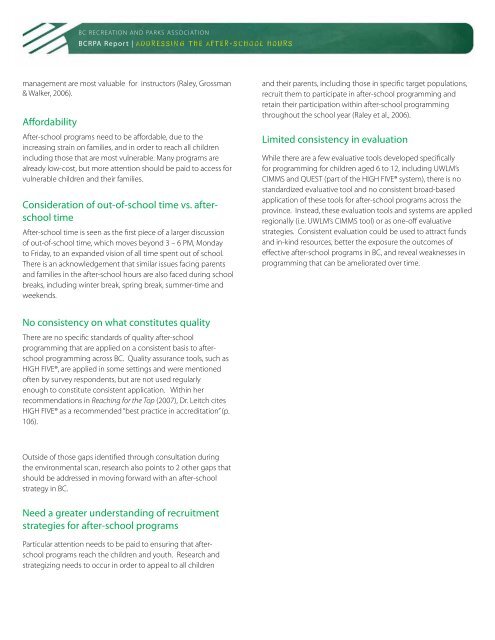BCRPA Report: Addressing the after-school hours - Middle ...
BCRPA Report: Addressing the after-school hours - Middle ...
BCRPA Report: Addressing the after-school hours - Middle ...
Create successful ePaper yourself
Turn your PDF publications into a flip-book with our unique Google optimized e-Paper software.
28 | www.bcrpa.bc.ca<br />
BC RECREATION AND PARKS ASSOCIATION<br />
<strong>BCRPA</strong> <strong>Report</strong> |<br />
management are most valuable for instructors (Raley, Grossman<br />
& Walker, 2006).<br />
Affordability<br />
After-<strong>school</strong> programs need to be affordable, due to <strong>the</strong><br />
increasing strain on families, and in order to reach all children<br />
including those that are most vulnerable. Many programs are<br />
already low-cost, but more attention should be paid to access for<br />
vulnerable children and <strong>the</strong>ir families.<br />
Consideration of out-of-<strong>school</strong> time vs. <strong>after</strong><strong>school</strong><br />
time<br />
After-<strong>school</strong> time is seen as <strong>the</strong> first piece of a larger discussion<br />
of out-of-<strong>school</strong> time, which moves beyond 3 – 6 PM, Monday<br />
to Friday, to an expanded vision of all time spent out of <strong>school</strong>.<br />
There is an acknowledgement that similar issues facing parents<br />
and families in <strong>the</strong> <strong>after</strong>-<strong>school</strong> <strong>hours</strong> are also faced during <strong>school</strong><br />
breaks, including winter break, spring break, summer-time and<br />
weekends.<br />
No consistency on what constitutes quality<br />
There are no specific standards of quality <strong>after</strong>-<strong>school</strong><br />
programming that are applied on a consistent basis to <strong>after</strong><strong>school</strong><br />
programming across BC. Quality assurance tools, such as<br />
HIGH FIVE®, are applied in some settings and were mentioned<br />
often by survey respondents, but are not used regularly<br />
enough to constitute consistent application. Within her<br />
recommendations in Reaching for <strong>the</strong> Top (2007), Dr. Leitch cites<br />
HIGH FIVE® as a recommended “best practice in accreditation” (p.<br />
106).<br />
Outside of those gaps identified through consultation during<br />
<strong>the</strong> environmental scan, research also points to 2 o<strong>the</strong>r gaps that<br />
should be addressed in moving forward with an <strong>after</strong>-<strong>school</strong><br />
strategy in BC.<br />
Need a greater understanding of recruitment<br />
strategies for <strong>after</strong>-<strong>school</strong> programs<br />
Particular attention needs to be paid to ensuring that <strong>after</strong><strong>school</strong><br />
programs reach <strong>the</strong> children and youth. Research and<br />
strategizing needs to occur in order to appeal to all children<br />
and <strong>the</strong>ir parents, including those in specific target populations,<br />
recruit <strong>the</strong>m to participate in <strong>after</strong>-<strong>school</strong> programming and<br />
retain <strong>the</strong>ir participation within <strong>after</strong>-<strong>school</strong> programming<br />
throughout <strong>the</strong> <strong>school</strong> year (Raley et al., 2006).<br />
Limited consistency in evaluation<br />
While <strong>the</strong>re are a few evaluative tools developed specifically<br />
for programming for children aged 6 to 12, including UWLM’s<br />
CIMMS and QUEST (part of <strong>the</strong> HIGH FIVE® system), <strong>the</strong>re is no<br />
standardized evaluative tool and no consistent broad-based<br />
application of <strong>the</strong>se tools for <strong>after</strong>-<strong>school</strong> programs across <strong>the</strong><br />
province. Instead, <strong>the</strong>se evaluation tools and systems are applied<br />
regionally (i.e. UWLM’s CIMMS tool) or as one-off evaluative<br />
strategies. Consistent evaluation could be used to attract funds<br />
and in-kind resources, better <strong>the</strong> exposure <strong>the</strong> outcomes of<br />
effective <strong>after</strong>-<strong>school</strong> programs in BC, and reveal weaknesses in<br />
programming that can be ameliorated over time.


